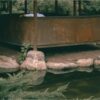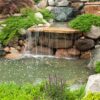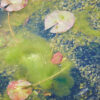How Many Fish on a Pond?
A backyard pond is an ideal place to gather and sit. But, if your ponds are ideal for uplifting your garden and providing it with an extra kick of beautification, the number of fish in your ponds is a crucial factor to take into consideration. Having 50 cats running around your house would certainly be a cause for concern and trouble. Similarly, the number of fish in your pond must be optimal to achieve the best natural and practical experience.
Stuffing too many fish in your pond, for added glory, can prove to be detrimental for your efforts because it will cause overcrowding, making your fish uncomfortable and risking their health.
The metric used by pond owners to gauge the number of fish in their ponds is fish per gallon. This reading will carefully explain the optimal number of fish to have per gallon, so sit back and relax as we take you through a fishy yet promising topic.
The Drawbacks of Having Too many Fish
As you increase the number of fish in your pond, the level of ammonia rises in the waterbody; increasing levels of ammonia can be fatal for fish as it significantly increases the toxicity. Why do ammonia levels rise? As fish eat, digest, and excrete, all these processes involve the release of ammonia gas. It is as simple as: more fish, more ammonia. The depletion of oxygen in the waterbody, caused by a buildup of ammonia, will cause algae blooms to rapidly grow.
Dangerously, algae blooms cover the upper surface of water, which does not allow oxygen and sunlight to travel beneath the lower layers; this treacherous reality will cause your fish to have practically no oxygen to breathe.
Next, overcrowding your pond with fish can reduce their ability to grow as they will not have space to swim and grow. Basically, they will have no room to stretch their legs.
Furthermore, with more fish, the production of sludge will immensely increase. Sludge is an arch nemesis of pond owners because it can decompose and affect the vital chemical balance in ponds. Moreover, it is evident that sludge buildup will increase the maintenance requirements of your pond.
How to Calculate Pond Size
Before jumping on to suggesting how many fish are ideal for a certain pond size, it is wise to understand the critical method of calculating your pond size, for greater accuracy and results. Use the formula: Length x Width x Depth = cubic feet x 7.5 = gallons. This is the universal formula for calculating the size of any pond.
Once you have calculated your pond’s size, and received a capacity in gallons, you can use the following rules before adding fish:
| Rule 1 | One 6-inch fish in 100 gallons of water |
| Rule 2 | 1-inch of fish in every 10 gallons of water |
| Rule 3 | 1-inch of fish for one square foot of surface area (24-inch deep pond) |
| Our Recommendation | To keep it simple, you can add 1-2 koi fish for every 200 gallons of water. Or, you can also add 2-3 goldfish. |
The 1-inch of fish per square foot is reasonable for new ponds. Once the pond has established its natural ecosystems and cycles, you can easily support 2-3 inches of fish per square foot.
There are some rules of thumb to follow as well. For every inch of koi, the pond owner should allot at least 35 gallons, and at least 20 gallons per inch of goldfish. Moreover, a typical pond having 500 to 3000 gallons is suitable for holding fish. Another rule of thumb is to allot 1 square foot of surface per inch to normally sized fish and 10 square feet of surface per inch for koi.
Similar to rabbits, fish reproduce at an astounding rate; pond owners should keep this into account as well. During the summer period, from February to September, fish reproduction is rapid. To keep this problem in check, many pond owners remove smaller koi and other fish from their ponds, and transfer them to separate tanks for their growth. The smaller fish can also be sold for a profit.
It’s Always Best to Add Fish Slowly
When adding new fish to your pond, it is best to add a few, only a handful, in each turn. This is because your pond’s natural biological filtration system is extremely sensitive and fragile to new change, hence it needs its proper time to adjust to new changes, such as waste levels.
It is recommended that you wait 4 to 5 weeks before introducing a new batch of fish to your pond.
Another decisive recommendation is to wait almost 6 weeks before adding fish to your new pond. Why the wait? The pond’s natural chemical balance takes time to regularize after setting up; the ‘Nitrogen Cycle’ is a process where debris is broken down and nitrates are released. The release of nitrates is crucial for the inculcation of healthy bacteria in your pond. The ‘Nitrogen Cycle’ is a dynamic process, which takes substantial time to adjust. Due to its credibility in raising beneficial bacteria, it needs time to stabilize because even the slightest of changes, such as adding external chemicals, will cause the cycle to get disrupted and ammonia levels to spike.
Factors to Consider Before Adding Fish to your Pond
Here is a list of imperative factors to consider before adding fish to your pond:
- Total surface area
- Pond volume
- Climate
- Temperature
- Filtration system
- Pond cleaning products
- Air flow; aeration
Also, ponds with aquatic plants will allow for a better sustenance for your fish because these integral species of plants are great for maintaining oxygen and filtration rates inside the pond.
The total surface area of your pond is extremely indispensable because it is at the surfaces where oxygen transfers take place. By no means are we saying bigger surface areas are better. Instead, your pond’s total surface area, which includes its height, width, and breadth, should be proportionate. For instance, a deep pond with a small bottom surface area will cause insignificant oxygen levels to be transferred.
Volume is equally important because effective fish movement is vital for boosting their size, strength, and livelihood. Koi fish should always be kept in a pond which is at least 1m deep.
If you plan on keeping more fish, it is necessary to equip your pond with a strong and efficient filtration system. Filtration systems need no introduction; they are responsible for the upkeep of vital functions, such as:
- Cleaning the water from algae blooms and preventing them.
- Dispensing the pond’s waste.
- Preventing stagnation, allowing the pond’s surface to be free from algae buildup which hampers oxygen penetration to the bottom levels of the pond.
- Beautifying the pond as clean and fresh water adds to your pond’s visual aesthetics.
- Preventing foul odors to stench your pond.
- Ensuring a healthy, balanced, and clean ecosystem inside the pond.
Fish waste, in the form of phosphates, sulfates, nitrates, and other pollutants, can be easily broken down in a quick manner with pond cleaning tablets. Water clarifying solutions also get the job, of clearing the pond and uplifting its aesthetics, done.
One of the most common problems faced by pond owners is aeration. A lack of aeration, which is especially prevalent during summer, can breed a long list of other problems, hence its importance is exceptional.
To identify if your pond is lacking in aeration, common symptoms include:
- Fish panting at the surface for oxygen.
- Foul odor due to decaying organic matter is caused because of a lack of water aeration, movement, and oxygen levels.
- Considerable algae production.
Rest assured, aeration is an easy task to achieve, and many pond owners have been successful in achieving the ideal aeration for their pond at the lowest cost. How? You can take advantage of mother nature’s abundant gifts by equipping your pond with aquatic plants. Or, if you need quicker and effective results, you can bolster your pond with an effective filtration system. If you prefer aesthetics, and devote a high priority to them, an amazing idea would be to add waterfalls or a fountain in your pond to maintain and improve water movement. Aside from all of these viable solutions, perhaps, the best solution for all of your pond’s aeration needs is to get your pond an air pump. A mechanical air pump is a resolute piece of equipment that will certainly provide your pond with the aeration it needs; however, the aeration will be artificial and might pose to be a nuisance if your mechanical water pump is too noisy.
The Best Way to Change Your Pond’s Water
Coming on to a pivotal aspect of pond maintenance, your pond’s water will need to be changed periodically. Partial water change, which means a 5% change of water, should be undertaken at the beginning of February, when the pond season starts.
During the summer period, which takes place from June to September, you will have to partially change your water on a monthly basis. The summer period requires a great deal of maintenance because natural decomposition and several other biological cycles are at their peak. This means that waste production will be at an all-time high during these months. The partial water change of 5% will allow the replenishment of cleanliness as waste will be removed.
Sludge is Your Pond’s Biggest Enemy
Sludge is an inevitable reality that every pond owner has to face. Meaning, it should be given great priority because it can potentially destroy your pond’s aquatic life and aesthetics if kept unchecked.
Sludge is caused by decaying organic matter. It sits at the bottom of your pond and on top, and causes algae blooms to appear, giving your pond the terrible green color. To make matters worse, sludge is the root cause of several dominant issues related to ponds, which include:
- Algae blooms
- Odor
- Toxicity
- Lack of oxygenation
The issue of sludge is highest during the summer period. Thus, it is important for pond owners to take a proactive approach in its prevention. This can be done through the removal of dead plants, fish, organic matter, and debris.
There are numerous ways to prevent sludge.
An effective filter will swiftly clean waste and provide the pond with a clean environment. A pump will increase aeration and water movement, which will prevent stagnation; a vital component of sludge creation.
A net cover on your pond will not allow leaves and other plant material to fall in your pond. This will allow less algae blooms to appear as their decomposition will not take place inside the waterbody.
If net covers do not suit your aesthetic, a common occurance against pond owners, you can possess a pole net which will allow you to manually remove debris and fallen leaves.
Pond vacuums are another impactful tool for your pond maintenance regime. Operating like conventional vacuum cleaners, they will remove the highest amount of debris and other organic material from the bottom surface of your pond using their incredible suction power.









